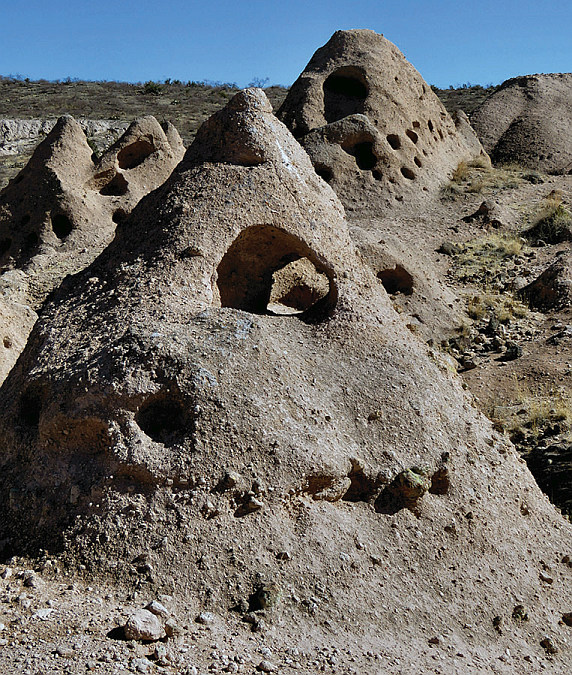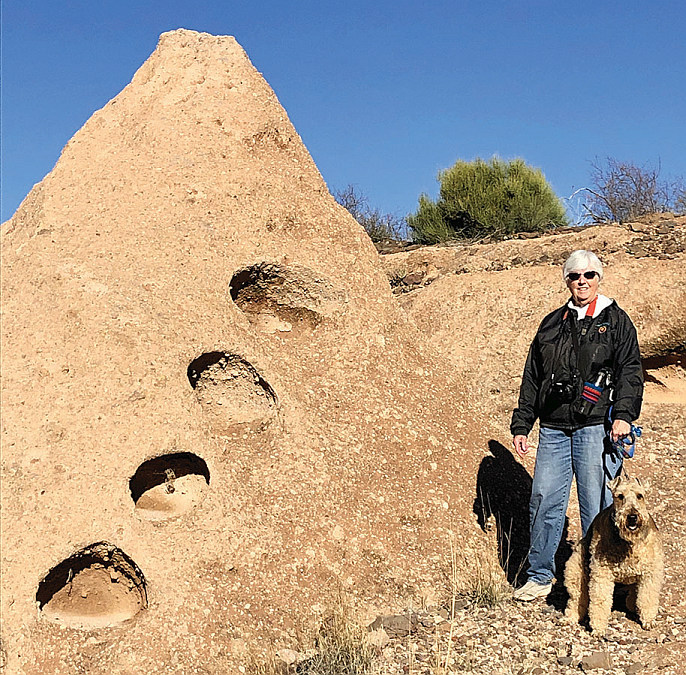Story & photos by Melissa Bowersock
As we hike the wilderness of our own backyards here in the Southwest, it’s hard not to combine the fresh air and exercise with more cranial pursuits. I’m talking about botany, meteorology, and geology to name just a few. Who can hike the Grand Canyon and not think about the millions of years of striated rocks laid down layer by layer, then cut through by the Colorado River and eroded by wind and rain? Every hike can be a mini-science lesson if we’re so inclined.
And while the Grand Canyon is awesome, dogs are not allowed on most of the trails, nor on the shuttle that takes people to the furthest reaches. Luckily, we have many fascinating places to hike in Arizona—smaller, yes, perhaps less grand, but interesting all the same.

Less than ten miles from Camp Verde is a place called the Cottonwood Fumaroles or, more familiarly, the Tee Pee Rocks. You might think a place so strange and other-worldly would be a popular destination, but the fact is, you won’t find the Tee Pee Rocks unless you know where to look, and even then, you can’t see them until you’re almost on top of them.
To get there, take Highway 260 east of Camp Verde about eight miles to the turnoff for Fossil Creek Road. Fossil Creek Road is a dirt road, but well-maintained so 4WD is not necessary. Go south about a half mile and look for a parking area on the right side of the road at the base of a tall hill. The area will look absolutely unremarkable, but don’t be fooled.
Park either there by the road or take a dirt track up around the left side of the hill. From here, you’ll be able to look down at the fumaroles in the valley below.
Ok, NOW it looks interesting. The rock formations below look exactly like a village of stone tee pees. Wind and rain have weathered holes in the rocks, adding another element of interest. So what happened to create this moonscape?
Fumaroles are vents or cracks in the earth’s surface that allow volcanic gases to escape from the depths. It’s believed these particular fumaroles formed seven million years ago when such vents developed beneath an older pyroclastic flow of tuff from nearby Hackberry Mountain, a volcano similar in type to Mt. St. Helens. The steam from below carried a large amount of calcium carbonate, which permeated the tuff, hardening into the cone-shaped rocks we see today.
A word of caution about getting down to the rocks. You can pretty much scramble down anywhere, although you may find some paths steeper or rockier than others, and you might end up carrying your dog over rough spots. If you stay to the left, there’s a pretty gentle descent that’s much easier to navigate. Once you get down to the valley floor, you can explore to your heart’s content.
The place is home to all sorts of critters: mice, ground squirrels, lizards, probably the occasional raccoon, coyote, or javalina, so there will be plenty of smells for your dog to investigate. I would strongly suggest that you check out any inviting water holes before your pup sticks his nose in, just in case there might be a sleeping rattlesnake in there. The same applies to charging into tall wild grass or thick brush: look before you leap, or go around. There are many trails that crisscross the area, so it’s not hard to find a clear path.

Annie certainly kicks into explorer mode whenever we go there, and she’s eager to investigate every rock, every hole, every wisp of grass that might have collected a stray scent. Trooper that she is, she’s willing to scramble up onto rocks or down into dry watercourses. She’s become an excellent trail dog, and goes everywhere we ask her to. That willingness makes for a great wilderness hike; we just have to do our part to keep her safe.
Winter is the perfect time to visit the Tee Pee Rocks. The cooler air keeps the temps down to a comfortable range, which is not the case in summer. In mid-summer when the sun is beating down on the light-colored rock, the heat radiates out and up from the ground, creating a very uncomfortable and even dangerous situation for dogs. For people, it might mean sweating profusely and needing more water; for a dog, it can mean death.
Whatever the season, take plenty of water and even a picnic lunch if you’re so inclined. You can spend the day exploring these fascinating rocks and pondering their violent origin. I don’t know about you, but I’m always a little humbled to stand beside a rock formation that could be seven million years old. It boggles the mind and has a way of putting our petty little troubles into perspective. We, along with our wonderful adoring pets, come and go, yet the earth, in all its fascinating variety, abides.

